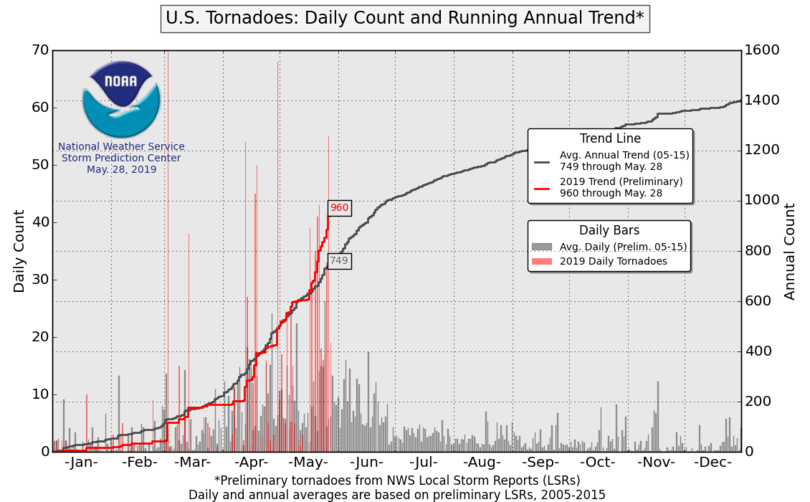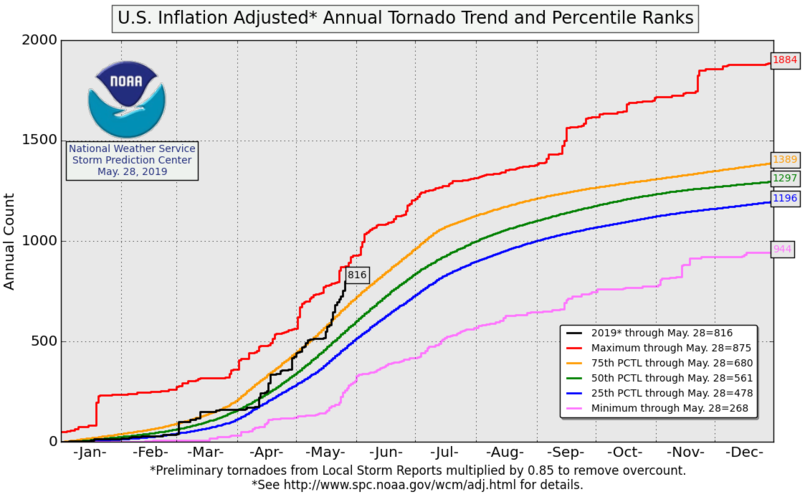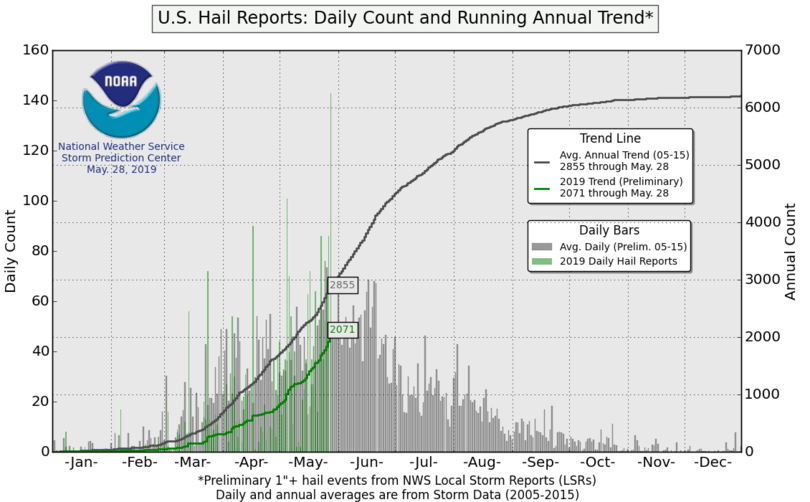Tornadoes that struck the U.S. in recent days, as well as strong and damaging winds and large hail, are expected to drive billions of dollars more in economic costs, as 2019 now moves above the long-term average in terms of the number of tornadoes counted by NOAA.
The severe thunderstorm and convective weather season in the United States has ramped up in recent weeks, with last week’s severe weather causing over $1 billion of economic losses, the majority of which is expected to fall to insurance and reinsurance capital, but then this week the tornado impacts have been far more severe it seems.
Just since Saturday of last week, May 25th, so after the above article was written, there are already reported to have been 145 tornadoes, 716 storm reports of high winds of 65kts or more and 553 reports of large hail of 2 inches in diameter or greater.
In total that makes for 1,414 storm reports recorded by NOAA, with the numbers likely to increase as additional tornadoes, wind and hail reports come in over the coming days.
Monday and Tuesday have been particularly dangerous this week, with 66 tornadoes reported on Monday alone, including one near Dayton, Ohio that has caused particular damage and is thought to have been an EF3.
Yesterday, Tuesday, tornadoes in Kansas caused destruction in some residential areas, while large hail was also widely seen, which as we know can be the largest driver of insurance and reinsurance market losses from these events.
The result is that the annual count for U.S. tornadoes has now risen well above the average for this point in the year, as the chart below from NOAA’s SPC shows.

Looking at the same statistic, but against other peak tornado years, 2019 now comes third and only to the destructive years of 2008 and 2014.

Finally, on an inflation adjusted basis, the number of tornado reports in 2019 comes above the 75th percentile now, falling just slightly behind the maximum seen at this point in the year.

There is a long way to go in the U.S. severe thunderstorm and convective weather season, with tornadoes seen at their peak in May and June but still occurring frequently typically until late July, but possible right through the year.
Hail storms that generate large and damaging hail stones are always a risk, but their occurrence is correlated with convective weather and tornadic storms are often the driver of the largest hail losses suffered for a big swathe of the United States.
The trend for large hail is currently running below the average annual, which is perhaps a little surprising given tornadoes exhibit the opposite. But perhaps this shows how the different climatic set-up is affecting damaging weather patterns in 2019, compared to other years.

The damaging tornadoes that affected the U.S. this week have caused significant damage and also loss of life.
The full financial cost of the impact of the tornadoes, large hail and damaging winds seen so far this week won’t be known for some time. But it’s likely to extend into the billions of dollars, a significant proportion of which is expected to be covered by insurance and reinsurance capital.
For today, NOAA also reports an enhanced risk of severe thunderstorms for parts of the U.S., with a warning area for areas of the southern Plains through the Ozarks, Ohio Valley and Middle Atlantic States.
NOAA explains:
“On the southern and eastern fringe of this convective cluster, more isolated storms are expected, within what is likely to be a thermodynamic and kinematic environment favorable for supercells. Given the more cellular storm mode expected, an enhanced risk for tornado potential appears to exist within a corridor from north-central Texas northeast across southeastern Oklahoma and into western Arkansas and possibly as far north as the Missouri Ozarks. Additionally, very large hail will be possible, along with locally damaging winds.”
It’s worth keeping an eye on our U.S. severe thunderstorm page which offers warning graphics, trend data and other useful information for assessing the threat level at any time during the year.
———–
 Register today to attend our next ILS conference in Singapore, ILS Asia 2019.
Register today to attend our next ILS conference in Singapore, ILS Asia 2019.
We’re returning to Singapore for our fourth annual ILS market conference for the Asia region. Please register today to secure the best prices. The last few Early Bird tickets are still available.
 View all of our Artemis Live video interviews and subscribe to our podcast.
View all of our Artemis Live video interviews and subscribe to our podcast.
All of our Artemis Live insurance-linked securities (ILS), catastrophe bonds and reinsurance video content and video interviews can be accessed online.
Our Artemis Live podcast can be subscribed to using the typical podcast services providers, including Apple, Google, Spotify and more.































